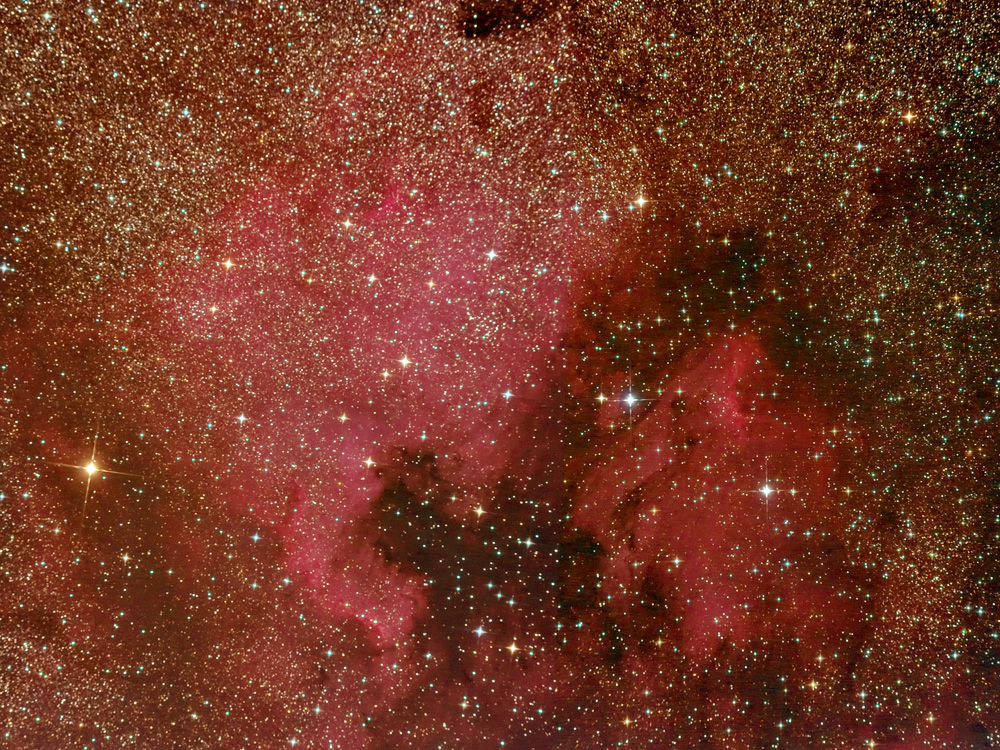
|
Le nebulose Nord America (NGC 7000) e Pellicano (IC 5067) The North America (NGC 7000) and Pellican (IC 5067) nebulas A.R. 20h55m - Decl. +44°10' Risoluzione 1800 x 1350 pixel |
|
Il complesso nebulare centrato sulle nebulose Nord America
e Pellicano è sicuramente uno fra i più estesi e famosi
fotografabili da un astrofilo. Nella seconda parte dell'estate è osservabile pressoché allo zenith per gli abitanti della zona temperata boreale. La sua osservazione non è facile in quanto, pur avendo una notevole luminosità complessiva è molto estesa. E' perciò più facilmente osservabile con strumenti a bassi ingrandimenti. Sotto cieli molto scuri la nebulosa Nord America, più brillante, è visibile anche a occhio nudo. La nebulosa Nord America deve il suo nome alla sua sorprendente somiglianza con il continente del nord-americano. Venne scoperto nei primi anni del decennio 1890 da Max Wolf. Sulla destra della Nebulosa Nord America, catalogata come NGC 7000, vi è la meno luminosa Nebulosa Pellicano, designata IC 5067-5070 dalla inconfondibile forma che ricorda l'uccello marino. Le due nebulose ad emissione misurano circa 50 anni luce, sono situate a circa 1500 anni luce di distanza, e sono separate da una nebulosa oscura denominata LDN 935 che fa anch'essa parte nel complesso nebulare. Il complesso nebulare si trova a circa 5 gradi a nord-est della brillante stella Deneb, nella costellazione del Cigno. Non è ancora noto quale stella sia responsabile della ionizzazione di questa enorme nube di gas idrogeno. The nebulosity centered on North America nebula and Pellican nebula is one of the most famous and largest that an astronomic amatheur could photograph. In the late summer people who live in the northern temperate belt could see it at zenith. It isn't a easy object to see because its light cover an area larger than ten full moons. It is easier to see with a binocular or with an low magnify optic. Under very dark sky you can see the most brillianti North America at naked eye. The North America nebula seems like the northamerican continents. Max Wolf discovered it in 1890. On east there is the fainter nebula IC 5067/5070 also known as Pellican Nebula, due to its shape that remind the sea bird.. These two emitting nebulas have a size of about 50 light years and are far about 1500 light years. Among them there is a dark nebula also know as LDN 935 that is in the same nebular complex.. You can find these nebulas about 5 degrees north-west from Deneb, alfa Cygni. |
|
Questa foto della nebulosa Nord America (NGC 7000)
e della nebulosa Pellicano, visibili nella costellazione
del Cigno,
è un mosaico di due riprese. La prima è stata scattata il 9 agosto 2007 dal Parco Faunistico del Monte
Labro (GR) al
fuoco diretto di un telescopio Takahashi FS60C (60 mm F:6) su
montatura Gemini G41 Obs con Fs2. Mentre la seconda è stata
scattata, dal medesimo posto e con la medesima attrezzatura il
11 agosto 2007. La prima foto è la somma di 11 esposizioni da 8 minuti cadauna, con una fotocamera digitale Canon Eos 300D con filtro modificato, settato a 400 ISO, mentre la seconda è la somma di 16 fotogrammi di sei minuti ciascuno sempre a 400 ISO. Le foto sono state effettuate con inseguimento mediante rifrattore 102/500 in parallelo e autoguida SBIG ST4. Successivamente i frames sono stati sommati con DeepSkystacker. Dopo avere unito i due files e bilanciato il fondo cielo, è stato elaborato separatamente il segnale di luminanza mediante stretching, maschera sfocata e riduzione del rumore. Successivamente è stato riunito il file di crominanza e bilanciato il colore. This photo of the North America Nebula (NGC 7000) and the Pelican Nebula (IC 5067/5070), in Cygnus is a mosaic of two separate sequence taken in different nights. The first one was taken on august 9, 2007 while the second one on august 11, 2007 from the Faunistic Park of Labro Mount, in Italy, near Grosseto, at the prime focus of a Takahashi FS60C telescope (60 mm F:6) using a Gemini G41 Obs mount with Fs2. The first photo is the sum of 11 frames, each of 8 minutes, with a Dslr camera Canon Eos 300D Rebel (filter modified), exposed at 400 ISO while the second is the sum of 16 frames, each of 6 minutes, exposed at 400 ISO, both taken with a Sbig ST4 autoguide on a refractor 102/500. I summed the frames with DeepSkyStacker. Then I composed the mosaic balancing the background. Later I processed the luminance layer using a stretching, an unsharp mask, a noise reduction. At last I joined the layer together with the crominance and balanced the color. |